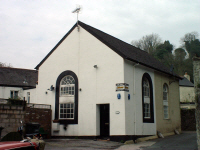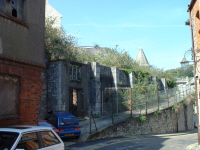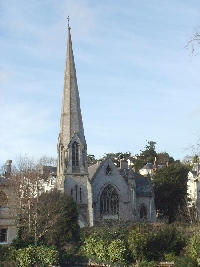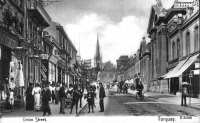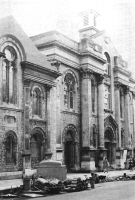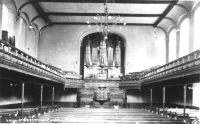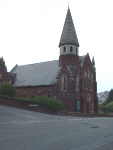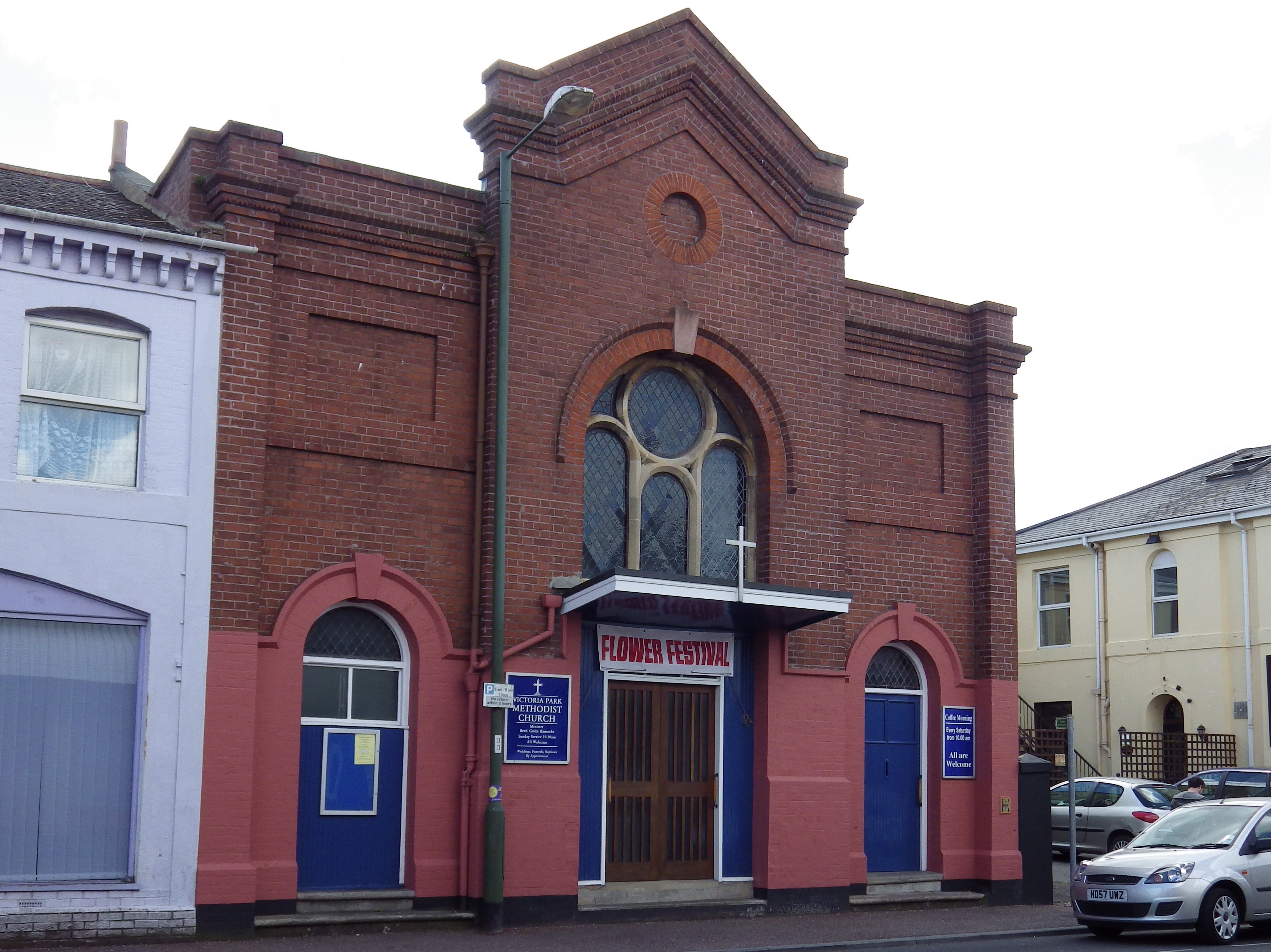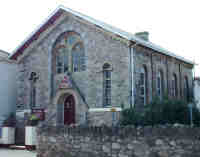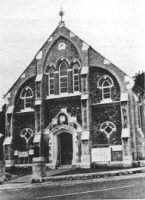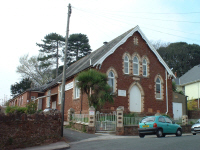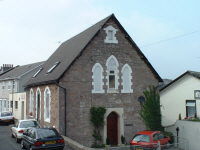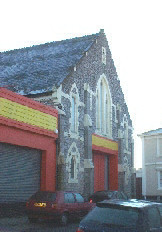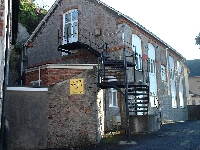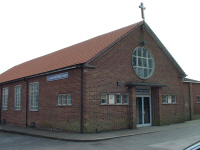TORQUAY
CHURCHES
Wesleyan, United
& Primitive Methodists (Inc:
Bible Christian Chapels)
During
much of the 19th century there were five independent
Methodist denominations or "connexions"
in England. Three of them united in 1907 to form the United
Methodist Church, while there was a final union in 1932. The
Wesleyan church was spread across the country but the others
were more regionally based. For example the Primitive
Methodists were strongest in the midlands and north but
wealthy members retired to the south coast of Devon, which
encouraged the establishment of a chain of their chapels in
our sea side towns, (with thanks to Roger Thorne FSA)
It is said that
Methodism in Torquay was
introduced into the area by John Henley who, with his brother
Edward went to Exeter to hear John Wesley preach. Upon
returning home he used his front parlour
at his house in Barton as a preaching place. It is thought
that a small thatched chapel was erected at some stage Then
this little chapel, tucked away just off Fore
Street, Barton, was built and is said to
be over 200 years old, it has been called the "Mother
of Wesleyan Methodism". In 1883 this
chapel and its counterparts in Torquay
itself came under the Teignmouth circuit which extended from Torquay right up to Dawlish and
included over 20 different places
Edward Henley was
responsible for bringing Wesleyanism
to Torquay proper and at first
used a room in George Street. In 1807 a small chapel was built
in this became known as "The Chapel in the Meadow" its
entrance was in Swan Street, today the site is totally built
over. Edward's daughter started a Sunday School
in a room on Warren Hill but in 1850 moved to the same
building as Mr Pengelly's
schoolroom. In 1853 the small chapel in the meadow was given
up for a far larger building in Rock Road. The photo above
shows all that remains of the Wesleyan Rock Road Chapel,
When built it was highly visible
but subsequent redevelopment of Fleet Street meant it was
hidden from view. It was a big place with seating for 1000
people, In 1859 schools were added
(was next door to the British School on the Congregational
page). After a period of 25 years it was decided to branch out
from Rock Road.
Western Times - Saturday 06 August 1881
TO be SOLD by Wednesday, August 10th the
MODERN FITTINGS of the Rock-road Wesleyan Chapel,
Torquay comprising Seating of the Chapel and
Galleries for 700 people, Pulpit and Communion Rail, 10
good new Columns, about 300 feet of 3 inch Hot-water
Pipe, Boiler, &c. Cost over £700. Price £70. If not
disposed of by above date the whole will be Sold by
Auction.—Any communications to be addressed to Mr.
G. FRADD, Auctioneer, Union-street, Torquay
I cannot find, at the moment when the site was finally
abandoned and the buildings demolished, for many years the
premises were used as a laundry and were still standing in
1963. The Sunday School
moved to Union Street in 1878. There are plans in hand
to build on the site (2015)
In order to meet
the needs of the eastern part of town several members of Rock
Road Chapel obtained a site in Babbacombe
Road, next door to the TNHS Museum, and on 7th January 1874
the new Wesleyan church was opened. This building
could accommodate 900 people It
was put up for sale in 1987, and was bought by the Elim Pentecostal Church, and is now a
Church of the Living Waters
Another new
Wesleyan Chapel was deemed necessary and a site was obtained
in what was then Lower Union Street, and the memorial
stones were laid on 6th November 1877 and it was opened in
1879- on the right of this photo. The school rooms which were
next to this chapel opened in December 1878. The combined
buildings had a frontage of 110 feet. The chapel would seat
1000 people, and the schools would accommodate 300 children.
This building was
destroyed by fire in 1926 and then rebuild.
In the early
seventies after discussions with the congregation at Belgrave Congregational Church and the
congregation at the Market Street Primitive Methodist Chapel
it was decided to dispose of the Union Street and Market
Street sites and to rebuild a complete new church on the Belgrave site- This came to fruition
as Central Church (see Congregational Page for picture)
A Picture of the
church just before demolition in the 1970s
A nice interior
view of the Chapel
The local
preachers at the Union Street Wesleyan chapel decided that the
growing district of Chelston
needed investigating and they decided to establish a Society
there and so in 1887 the first services were held in a room
over a stable in Walnut Road, after a couple of changes of
venue including a house called Mapledene
and a newly finished empty house Richard Mallock
granted them a lease on a piece of land and Chelston Methodist Church
at the bottom of Huxtable Hill opened in 1893, it comprised a
chapel seating 500, and still in use today
Victoria Park
Wesleyan Chapel, was built in 1864. The area (known then as
Boston Fields) was used for temporary housing for people
displaced from the poorer areas of the town following a
cholera outbreak in 1849, at this time the houses were timber
built but were later replaced by rows of stone built terraced
houses. Still in use today and the area is now known as Plainmoor
The Primitive
Methodists were an off shoot of the Wesleyans and their
first local society was founded in Babbacombe
in 1863. The foundation stone of this chapel was laid in June
1868 and it opened in October of the same year. There is a
large school room underneath. This building has had a varied
career, being used by the "Brethren" in 1961 and today is a
Children's Nursery. The building is known as the "Kingsway Hall"
Market Street
Primitive Methodist Chapel. The Primitive
Methodists first held their meetings in a prayer room in Union
Street, then buying the old Baptist Chapel in Temperance
Street in 1863 which they opened on 26 July of that same year.
They then purchased a large house in Market Street and in 1877
the foundation stones were laid, the new church opening in
1878. Later a hall and other ancillary buildings were erected
at the rear.
J. C. Dinham, the well
known Victorian photographer was in charge of the
music here. Dry rot and troubles with the heating system were
discovered in the 1970s and the building was finally abandoned
in 1973 when the heating system failed, the congregation
joining the Union Street Chapel. The site was sold , the chapel demolished and a
block of flats erected on the site. Part of the money from the
sale was used to help build the new Central Church
Another
denomination, called the Methodist New Connexion, was based in the
urban midlands and north, and their single chapel in Devon was
due to just one wealthy member, who retired to Torquay. Joseph Hepworth (1834 - 1911)
left school at ten and worked in a mill but after moving from
Huddersfield to Leeds he founded
the well known men's clothing
business. In due course he became a Liberal alderman, a JP and
Lord Mayor of Leeds. He was a leading member of the Methodist
New Connexion and an office
holder in the Woodhouse Lane MNC Circuit. When he retired to Torquay for his health he found no New
Connexion chapel there so he
bought the independent Mission in Innerbrook
Road and in 1904 installed a retired Methodist Minister. This
was the only MNC chapel in Devon and private enterprise at
that! However his old circuit valued him so much that, when he
moved to Torquay, they would not
release him so he maintained his membership and offices, which
were discharged by his son. The Innerbrook
Road chapel was opened by Mr Levi
Powell in October 1897 as an undenominational "People's
Mission" with 250 seats. It was built of red sandstone and
white brick. Despite attracting good congregations of working
class people at first, finance became a problem as "it was
loaded with debt". In May 1903 Joseph Hepworth bought the
premises and it became a New Connexion
chapel, with a succession of ministers. Happily the old
congregation kept coming. In 1908 he paid off the outstanding
debt and gave it to Trustees. It was extended in 1909. For
some time before it closed it was used as a "Children's
chapel" run in association with the Zion Methodist Chapel,
Torre. It closed in 1936, after the second Methodist Union of
1932, which resulted in too many chapels. It was sold to Torquay Town Council in 1944. After
closure it was used as a schools' kitchen. Above the door is
an inscription "The People's Mission 1897" and on the
extension a stone "Laid by Mrs
Hepworth of Hazelwood Torquay
14th April 1909".
The above is
copyright Roger Thorne FSA, and used with his kind permission.
This building was
later used as a fitness centre,
now converted to residential use.
In 1906 several
smaller branches of Methodism became the UNITED METHODIST
Churches and this then brought the Bible Christian Chapels
under the Methodist umbrella
Samuel Jory leased
the land in 1862 from Sir Lawrence Palk and opened, in 1863,
this little Bible Christian Ebenezer chapel in Western
Road, St Marychurch.
It could seat 100 people and had two small classrooms and
a vestry. In 1906 it became a United Methodist chapel.
It continued in use until being put up for sale in 1954. For
many years it formed part of the premises of the Lowndes Pateman businesses, and in 1990 was
converted into two houses.
The Bible
Christians established themselves in Torquay in the 1840s and in 1849
opened a little chapel in what was called Masons Row (now
Laburnum St). In 1864 the new ZION chapel was opened
on Torre hill. In 1905 had approx
200 members. Became a United Methodist chapel in 1906.
This building was also sold off in 1954 and went into
commercial use, there is nothing left of the inside, the
galleries and all the fittings are long since stripped out and
a large commercial roller shutter door fitted. Was used as a tyre depot for years and is now used
by a firm of motor mechanics.
To the rear of the
Zion chapel was erected a schoolroom ,
infants room, three vestries, and a Manse for the minister.
This photo shows the school rooms which are still standing
During 1935, thanks to the Rev Carr of Abbey Road Congregational
Church, the first non-conformist services were held in Shiphay- these took place in the
tennis pavilion in Banbury
Park. A building fund was started two years later and the
site for a Methodist church was purchased. On 16 May 1938 the
site was dedicated, again WW2 interfered with the plans. After
the war, when building development started and roads were
widened and new ones laid out ,
part of the site was lost. It was then considered too small
and so it was sold and a new elevated site purchased,
just off Collaton Road- access
was going to be a problem until new roads opened up
access to-
St Andrews
Methodist Chapel, Shiphay,
The foundation
stone being laid on 31 December 1952 and the church opened in
September 1953. Built more in the style of a church hall,
presumably to get optimum use out of the building. Still in
use
For a short time a
similar building, known as St George's, was in use in
Fore Street, Watcombe, built in
1954 as a replacement for both the Barton Chapel and the
Western Road chapel. Quickly fell into disuse and demolished,
the land now used for housing

